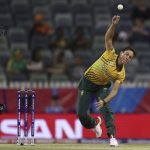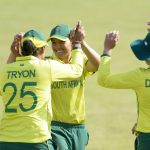The gifted Gregory Mahlokwana bowls both ways
The young, ambidextrous bowler was almost lost to cricket as a more certain career in law enforcement beckoned. But a chance meeting with his idol gave him the chance to pursue the pitch.
Author:
18 April 2020

Statistically, just 1% of the world’s population is ambidextrous. But the ability to use both hands with equal strength and skill in a sport like cricket could prove priceless to a player’s aspirations, as well as a country’s cricketing fortunes. So why do cricket coaches not encourage playing with both hands in a game that can so obviously accommodate it?
The frequency with which reverse sweeps and overhead lap shots are played in the modern game may convince some that there is no need to ponder on leftist and rightist philosophy. It’s difficult enough being the best with one dominant hand, others might say, so to train the other to be as good requires a greater level of physical and mental fortitude. Science, meanwhile, has warned that forcing young people to be ambidextrous can stunt the brain’s natural development.
In cricket, some of the sport’s greats have batted and bowled with opposing hands. But ambidextrous bowlers are even rarer. As the game evolves and teams search for new and innovative ways to win, this is a talent that could get a player noticed, which is what happened to South African first-class cricketer Gregory Mahlokwana. Northerns Cricket Union and the Titans franchise were so impressed that in 2017, former Proteas allrounder Albie Morkel and then Titans coach Mark Boucher convinced the young man to cut short his studies in the Eastern Cape and move back to Gauteng.
Related article:
While playing cricket for the Mamelodi Cricket Club in Pretoria in 2015, Mahlokwana caught the eye of then Northerns Cricket Union chief executive Johan Muller, who facilitated a Cricket South Africa bursary for Mahlokwana.
“I was studying marketing through Mind Skill College, but I was playing cricket for the University of Fort Hare. I was there for two years,” Mahlokwana said. “In 2017, I came back home for a bit and I was bowling in the nets for the Titans players during practice. The following day we were due to play against the Warriors, and they thought they needed a left-arm offspinner. So I was just there to bowl in the nets. That’s when Mark Boucher and Albie Morkel saw me.
“They asked me about myself and I told them I’m playing club cricket in the Eastern Cape. They said, ‘No, rather come home.’ They then organised something for me and brought me in, which was nice.”
The 25-year-old from Cullinan, east of Pretoria, started playing cricket in 2006 and only bowled spin because of his lack of stature, a physical trait associated with many spinners. “The team needed a spinner and I was the shortest guy on the team, so I had to bowl spin,” Mahlokwana said. “I later made the Standard Bank Under-13 team as a spinner.”
How he learned to use both hands
While most ambidextrous athletes are bred from a young age, it wasn’t until Mahlokwana broke his left thumb as a teenager that he tried to bowl with his right arm. “It happened while practising spin [in 2006]. I told myself, ‘You might as well try to spin with your right hand now,’ even though I’m left-handed,” he said.
He did so in the hope of keeping his place in the team and remaining focused on a sport he was growing to love more each day.
“I started playing cricket at Chipa-Tabane High School and I matriculated in 2013. In 2014, I stopped playing cricket because I was studying policing at Pretoria Technical College. I thought that if I don’t make it in cricket, maybe I should try something else.”
Related article:
At the age of 19, a young black man with no safety net at home, he needed to rely on something besides cricket. His life had changed in 2009, when he was just 15, and he had to grow up quickly. “It’s been tough since high school, when I lost both my parents. I lost my mom in 2009 and my father in 2011. It’s mostly my brother who has been there for me,” he said.
With that pressure on his young shoulders, Mahlokwana seized the opportunities that came his way to make a play for a career in the game he’d always loved.
“We are seven at home and I’m the last-born. We are four brothers and three sisters. I live with my family, but I had a friend who helped me a lot,” he said. “We have been friends since primary school. His mother and my late mother were friends and since the passing of my mother, she has been there for me, giving me a lift from Cullinan to Northerns cricket matches.”
Showing SA what he has
Because of a virtual blackout of televised domestic cricket matches, Mahlokwana’s ambidextrous ability only really caught the public eye during the 2019 edition of the Mzansi Super League, when the young allrounder turned out for the Cape Town Blitz. He didn’t set the pitch alight, but did show his potential to confound batters in the helter-skelter Twenty20 format.
In one spell against the Durban Heat, Mahlokwana dismissed opener Sarel Erwee with his right arm in the eighth over. In his next over, he switched to his left hand and sent down a quicker delivery to bowl Dane Vilas out. He ended with figures of 2-26 on that day.
“I always believed from a young age that I could use both hands. I always bowl with both hands. If maybe the left hand doesn’t work, that’s when I change,” said Mahlokwana. “The left hand is the one that I can do anything with, but the right is just a weapon. It’s funny now because when I bowl right-handed, the ball turns more than when I use the left hand.”
The debate around producing more ambidextrous cricketers has ebbed and flowed for a few years already. Former Australia coach John Buchanan said he believed strongly in the need to coach and produce more cricketers who can bat, bowl and throw with both hands. His ideas were dismissed by most observers, who felt that ambidextrous bowling was too incredibly difficult to master because it involved rewiring a player’s brain. It was more difficult than being able to hit reverse shots. This was training and conditioning the body and its muscles to learn, and the returns on that hard work were minimal.
Related article:
Sri Lankan spinner Kamindu Mendis, his Indian spin counterpart Akshay Karnewar, Pakistan’s Yasir Jan, cricket’s only ambidextrous pace bowler Shaila Sharmin, who plays for the Bangladesh women’s team, and Australia’s Jemma Barsby make up a rare club of ambidextrous bowlers who have chosen to embrace that challenge.
Now Mahlokwana hopes to join this elite group by plying his ambidextrous skill in more formats of the game. “I never felt any pressure. As an individual I just told myself, ‘It’s not going to be easy to make the Titans because there are a lot of Proteas guys who are coming in.’ So I told myself, ‘Whenever I get to play, I just need to perform,’” he said. “For now, my goals are to play all the formats for the Titans. I was classified as a white-ball player, but I’ve just made my debut in four-day cricket [in South Africa’s 4-Day Domestic Series] for the Titans, which is something that I’m happy about.”
Perhaps the dearth of ambidextrous bowlers is down to conservative coaching and rigid cricketing structures that prevent players from exploring their more creative abilities. Then there is cricket’s innate conservatism, which insists a bowler announce the arm he’s bowling with but allows batters to switch-hit in a split second at any point.
Related article:
Lefties like Mahlokwana are more likely to be ambidextrous because they have more functionality in their right hands than right-handers have in their left hands.
With a host of Proteas in the Titans for Mahlokwana to feed off and learn from while he sets his sights on higher honours in years to come, he feels he has the right platform to express his talents.
“It’s always nice to have those guys around because they have so much information about what’s going on, what I must do as a youngster in order for me to improve,” Mahlokwana said. “My idol has always been Albie Morkel and I was happy I had a chance to share the same change room with him. Outside of cricket, it’s my brother. He’s been there for me, in terms of giving advice, since I started in high school until now. He still advises me. The funny part is he doesn’t know anything about cricket.”




